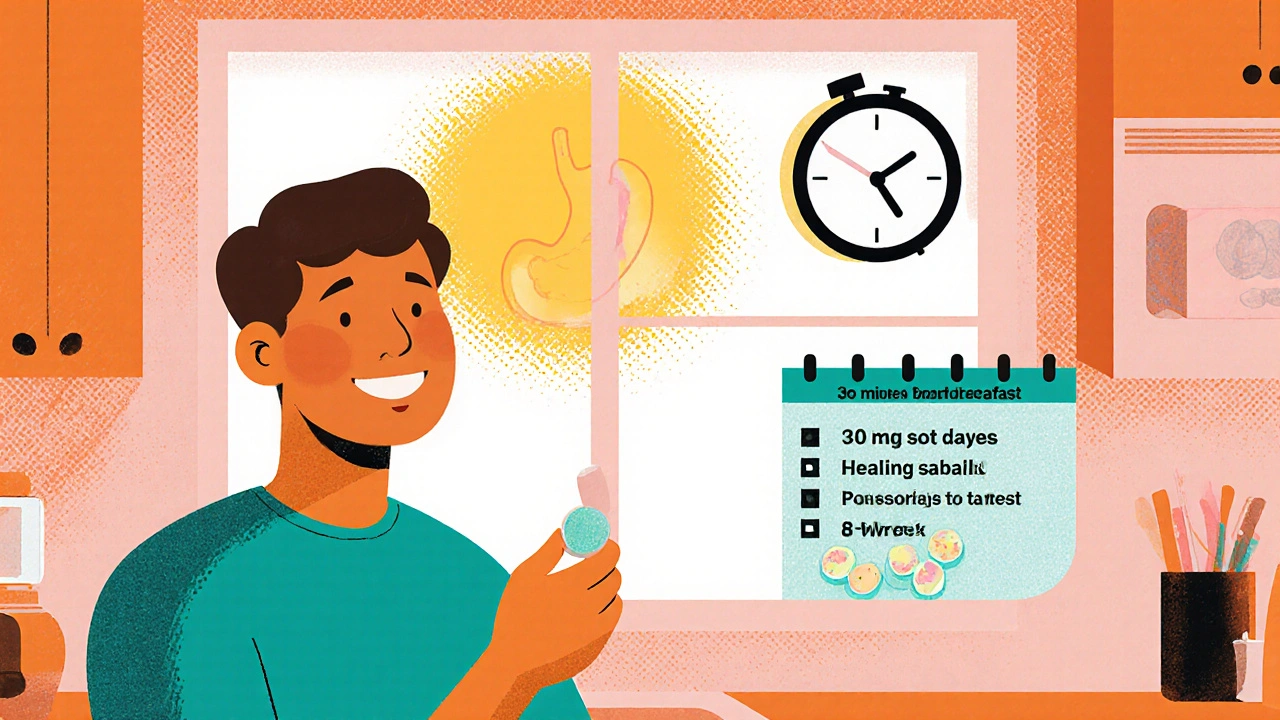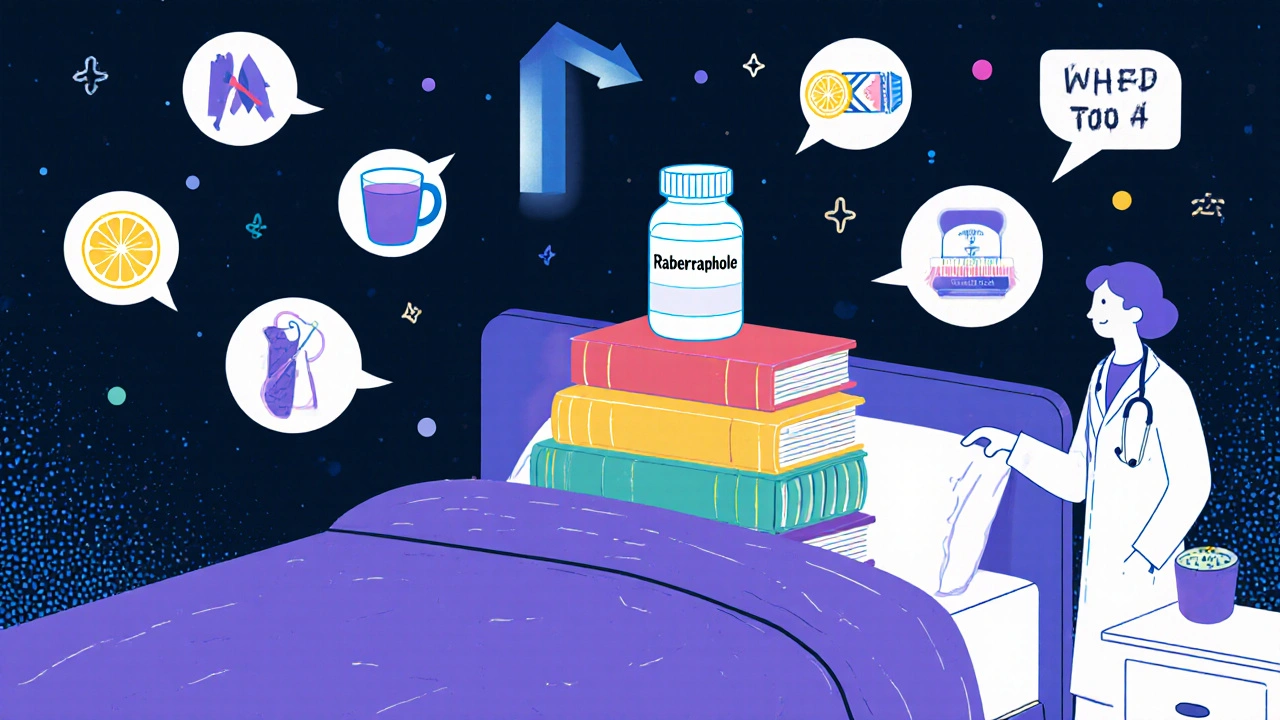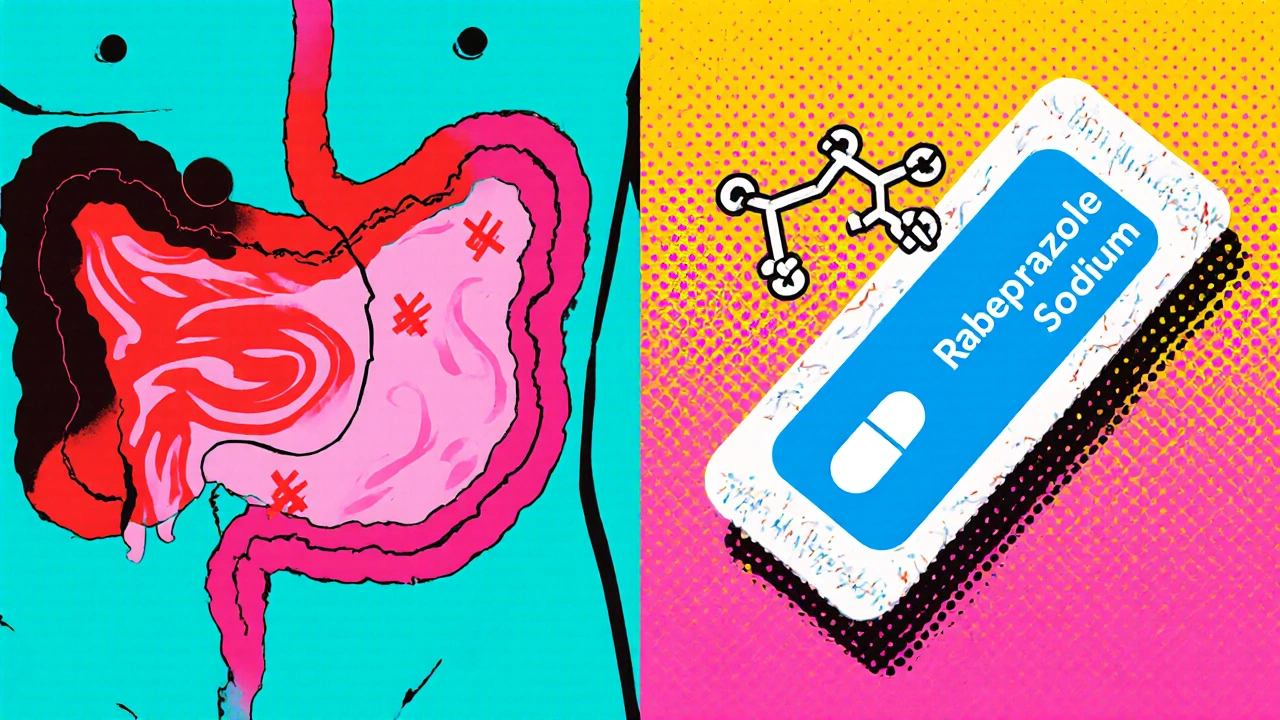If you’ve been diagnosed with gastro‑esophageal reflux disease (GERD) and your doctor mentioned rabeprazole sodium, you probably have a lot of questions. This guide walks you through what the drug is, how it works, the right way to take it, what to watch out for, and how it stacks up against other acid‑blocking meds.
What Is Rabeprazole Sodium?
Rabeprazole Sodium is a prescription medication classified as a proton pump inhibitor (PPI). It reduces stomach acid by blocking the enzyme H+/K+ ATPase in the parietal cells of the stomach lining. The brand name often used in the U.S. is Aciphex, but generic versions are widely available.
How It Works - The Science Behind Acid Suppression
PPIs like Rabeprazole Sodium target the final step of acid production. By inhibiting the proton pump, they lower the volume of gastric acid secreted, allowing the esophagus and stomach lining to heal. This mechanism differs from H2‑blockers (e.g., ranitidine) which only curb acid release indirectly.
When you take a dose, the drug accumulates in the acidic environment of the secretory canaliculi and forms a covalent bond with the pump. The effect lasts longer than the drug’s half‑life, providing up to 24‑hour acid control with a once‑daily dose.
Dosage Guidelines for GERD
Typical prescribing patterns for GERD are straightforward:
- Adults: 20mg taken orally once daily, preferably 30minutes before breakfast.
- Severe or erosive esophagitis may require 20mg twice daily under physician supervision.
- Duration: Most clinicians recommend an 8‑week trial before reassessing symptoms.
When switching from another PPI, a simple 1‑to‑1 conversion is common, but always confirm with your prescriber. For patients with impaired kidney function, dosage adjustments are rarely needed because the drug is primarily metabolized by the liver via CYP2C19 and CYP3A4 pathways.

Common Side Effects and Safety Considerations
Like any medication, Rabeprazole Sodium carries a risk profile. Most users experience mild, transient issues:
- Headache - reported in about 10% of patients.
- Diarrhea or constipation - usually resolves after a few days.
- Nausea or abdominal discomfort - often linked to taking the pill without enough water.
Serious, though rare, adverse events include:
- Clostridioides difficile infection - prolonged acid suppression can alter gut flora.
- Bone fractures - long‑term use (beyond 1year) may affect calcium absorption.
- Vitamin B12 deficiency - reduced acid can impair B12 release from food.
Pregnant or breastfeeding women should only use Rabeprazole Sodium if the benefits outweigh the risks, as safety data are limited.
Comparing Rabeprazole with Other PPIs
Choosing the right PPI often depends on how quickly it works, drug‑interaction potential, and cost. Below is a quick side‑by‑side look at the most common options.
| Attribute | Rabeprazole | Omeprazole | Esomeprazole | Lansoprazole |
|---|---|---|---|---|
| Onset of Action | 1-2hours | 1-3hours | 1-2hours | 1-2hours |
| Typical Dose for GERD | 20mg QD | 20mg QD | 20-40mg QD | 15mg QD |
| Metabolism Pathway | CYP2C19, CYP3A4 | CYP2C19 | CYP2C19, CYP3A4 | CYP2C19, CYP3A4 |
| Drug‑Interaction Risk | Low | Moderate | Moderate‑High | Low‑Moderate |
| Cost (generic, US) | $$ | $ | $$$ | $$ |
In practice, many clinicians favor rabeprazole for patients who take multiple medications, thanks to its relatively low interaction potential. However, insurance formularies sometimes push cheaper options like omeprazole, so weigh cost against convenience.

Managing GERD Beyond Medication
Even the best PPI won’t fix GERD if lifestyle factors stay the same. Pair your prescription with these evidence‑backed tweaks:
- Elevate the head of your bed 6-8 inches to reduce nighttime reflux.
- Limit acidic foods (citrus, tomato sauce), coffee, and alcohol.
- Avoid large meals within three hours of lying down.
- Maintain a healthy weight; excess belly fat increases intra‑abdominal pressure.
- Consider chewing gum after meals - it stimulates saliva, which neutralizes acid.
Tracking symptoms in a diary can help your doctor fine‑tune the dosage or decide whether a step‑down plan is appropriate after symptom control.
Frequently Asked Questions
Can I take Rabeprazole Sodium with other medications?
Because rabeprazole is metabolized mainly by CYP2C19 and CYP3A4, it has fewer interactions than some PPIs. However, caution is advised with drugs that rely on stomach acidity for absorption, such as ketoconazole or atazanavir. Always list every medication to your pharmacist.
How long should I stay on Rabeprazole for GERD?
Most guidelines suggest an 8‑week course for uncomplicated GERD. If symptoms persist, a doctor may extend therapy but should reassess the need for long‑term use because of fracture and infection risks.
Is it safe to stop the medication abruptly?
Abrupt discontinuation can cause rebound acid hypersecretion, leading to worsening heartburn. A taper-reducing the dose or switching to an H2‑blocker for a few weeks-is recommended.
Can I use Rabeprazole while pregnant?
Animal studies show no major teratogenic effect, but human data are limited. The drug is classified as Category B; only use if the doctor deems the benefit outweighs potential risk.
What should I do if I miss a dose?
Take the missed tablet as soon as you remember, unless it’s near the time of your next dose. In that case, skip the missed dose and continue with your regular schedule. Don’t double‑dose.
Understanding how Rabeprazole Sodium fits into your GERD plan can make the difference between a few weeks of relief and a long‑term struggle. Combine the medication with lifestyle tweaks, stay alert for side effects, and keep an open line of communication with your healthcare provider.


Comments
alex montana
Wow!!! I read your guide and I'm freaking out!!! The way you explained the proton pump inhibition made my brain melt!!! But also, why does everyone keep ignoring the fact that long‑term use can lead to bone fractures??? I feel like the medical community is hiding something!!!
October 17, 2025 AT 19:52
Lyle Mills
The pharmacokinetic profile of rabeprazole, particularly its CYP2C19 metabolism, underscores its reduced drug‑interaction liability relative to omeprazole.
October 26, 2025 AT 02:52
Rohit Sridhar
Hey folks, great read! I love how you broke down the mechanism-it’s like watching a tiny factory shut down on command. If you’re new to PPIs, remember that consistency is key; taking the pill before breakfast really maximizes absorption. Also, pairing the medication with lifestyle tweaks can turn a modest improvement into a dramatic relief. Keep tracking your symptoms; a simple diary can reveal patterns you’d never notice otherwise. You’ve got this, and every step forward is a win!
November 3, 2025 AT 10:52
kendra mukhia
Honestly, this guide reads like a textbook tossed into a Reddit thread-highly detailed yet dripping with the smug certainty of someone who thinks they’ve mastered gastroenterology. While the data on rabeprasole’s low interaction profile is accurate, the author conveniently glosses over the financial burden on patients. The cost comparison table is half‑hearted, ignoring the fact that many insurers force you onto cheaper, less effective alternatives. If you’re truly seeking unbiased advice, you need to question why the “$$” symbol is used instead of actual price points. Moreover, the lifestyle recommendations sound like generic advice you’d find on a wellness blog, not a nuanced clinical discussion. In short, the article is useful *if* you can sift through the bias and fill in the gaps yourself.
November 11, 2025 AT 18:52
Bethany Torkelson
Stop sugar‑coating the side effects-anyone on rabeprazole knows the headaches can be brutal, and the insomnia that follows is a nightmare you shouldn’t ignore!
November 20, 2025 AT 02:52
Grace Hada
Rabeprazole exemplifies the paradox of modern medicine: it tames acid yet subtly erodes vital nutrients, a silent trade‑off demanding vigilant monitoring.
November 28, 2025 AT 10:52
Wyatt Schwindt
Take the dose with a full glass of water before breakfast for optimal effect.
December 6, 2025 AT 18:52
Nhasala Joshi
Reading this guide feels like uncovering a hidden layer of the pharmaceutical matrix 😱. The way rabeprazole is marketed as “low‑interaction” is suspicious, especially when big pharma quietly pushes off‑label uses that many of us don’t see. 🤔 They’ll tell you it’s safe for a year, then hide the data on bone density loss in obscure journals. Have you ever noticed how the FDA’s warning labels are tucked away in fine print while bright ads scream “relief now”? 🧐 The enzyme pathways - CYP2C19 and CYP3A4 - are not just biochemical facts; they’re gateways for the industry to control a swarm of generic competitors. Every time a new PPI hits the market, the old brands disappear, and we’re left buying whatever the insurers decide, often at a premium. 🏥 Meanwhile, the microbiome disruption leading to C. difficile infections is downplayed, as if the average patient will never read about gut flora in a 2020 study. 📚 And let’s not forget the subtle influence of dietary recommendations that push you toward “healthy” foods sold by the same conglomerates that own the medication patents. 😤 The lifestyle tweaks like “elevate your head of the bed” are harmless, yet they divert attention from the real issue: a system that profits from chronic medication. 🌐 If you’re not questioning who benefits from a decade‑long PPI regimen, you’re being used. The guide does a decent job of summarizing mechanisms, but it fails to name the shadow players behind the scenes. 🎭 It’s essential to stay vigilant, keep your own health data, and share experiences with a community that isn’t afraid to call out the hidden agenda. 💪 Remember, knowledge is power, and the more you know, the less control they have over your gut and your wallet. Stay skeptical of any claim that a single drug can replace comprehensive care. Your gut health deserves a strategy, not a corporate script.
December 15, 2025 AT 02:52
Barbara Grzegorzewska
Honestly, the discourse around rabeprazole reeks of mediocrity-one could argue it’s the epitome of American pharmaceutical bravado, yet the pricing feels like a covert tax on our patriotism. The “$$” notation is a lazy shorthand; we deserve transparent cost breakdowns, not cryptic symbols that hide the exploitation. It’s bafflin’ how the industry can swagger about generic availability while the average citizen forks over premium cash. In my view, a truly enlightened healthcare system would champion homegrown solutions over foreign conglomerates that masquerade as lifesavers. So let’s call out the pretence and demand real value, not hollow marketing.
December 23, 2025 AT 10:52